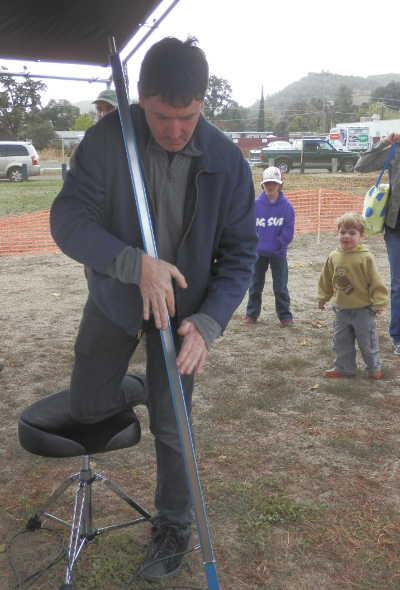HIDDEN VALLEY LAKE, Calif. – The State Water Resources Control Board has ordered the Hidden Valley Lake Community Services District to stop allowing new service connections to its water system due to concerns that, under current drought conditions, the district doesn’t have enough water to meet demand.
The temporary service connection moratorium, issued on Oct. 17, will remain in effect until the district fulfills the directives of a state-issued compliance order that requires an alternative source of water be established, according to state officials.
If the district doesn’t follow the state’s order, it could face citations and other administrative penalties.
Hidden Valley Lake was one of 22 districts in the state to receive the order. No other Lake County district received it, state officials confirmed.
The regulations from which the actions being enforced against Hidden Valley Lake arose were approved by the State Water Resources Control Board at its July meeting.
The agency said the regulations were developed following legislation signed by Gov. Jerry Brown that expanded regulatory and enforcement powers during the drought emergency.
Hidden Valley Lake has been categorized with several other smaller water districts in the “junior” rights designation as opposed to much larger “senior” rights holders in the Sacramento and the San Joaquin Valley.
An Oct. 17 letter to Roland Sanford, general manager of the Hidden Valley Lake Community Services District, signed by State Water Resources Control Board Engineer Michelle Frederick stated, “Because of drought conditions and senior water right demands, the Water Board’s Division of Water Rights determined that water was not available for Hidden Valley Lake Community Services District public water system’s Grange wells sources and notified the (district) of the need to curtail its diversions.”
Sanford’s reaction to the state penalty: “The allusion I use is we are caught in a giant net that was meant for smaller fish. The trick to is get out of this thing.
“My personal opinion on this is that we are a junior water rights holder but we do have a permit to divert water and a community of 6,000 people,” he added. “It’s not practical to shut us off.”
Sanford said the district will host a Nov. 4 workshop – the time of which has not yet been set – in order to help both the district board and residents better understand the circumstances that led to the connection moratorium.
Sanford believes that the curtailment notice issue is not closed and can be lifted through discussions with the state.
Water board officials said that any changes would require a process be followed.
The situation leading to the moratorium
Frederick’s letter explains that California Health and Safety Code Section 116655 requires each public water system in the state to have a reliable source of water to serve its customers.
In this case, the state estimates Hidden Valley Lake’s population at 5,600 residents, with 2,444 service connections. The district puts the number of residences at 6,000.
Her letter is accompanied by a 12-page compliance order because the state determined the district had violated Section 116655.
In May, the State Water Resources Control Board issued curtailment notices to junior water rights holders in the Sacramento River and San Joaquin River watersheds, the order explained.
At that time, the Hidden Valley Lake Community Services District was notified of “the need to immediately stop diverting under the System’s post-1914 water rights.”
Sanford said the district’s source of water in the impacted watershed is the Putah Creek underflow. He said the district has “appropriative” – defined as “first in time, first in right” – water rights to the underflow.
The Hidden Valley Lake Community Services District’s Grange wells are approved sources of water supply for the district. However, “Based on the Board’s water production and consumption records for the System, the Board has determined that without the use of the curtailed Sacramento River Watershed water right, the System is not able to provide an adequate and reliable supply of water to its customers for human health and safety uses,” the order states.
Sanford sent the state a letter, dated June 26, expressing concerns regarding the state’s drought-related emergency regulations and curtailment of diversions to protect senior water rights.
“While we understand the rationale for the proposed emergency regulations, we believe the regulations, as currently crafted, will unduly punish those entities that through favorable geography and/or significant water supply reliability investments are less affected by the ongoing drought, by subjecting them to remedies that are appropriately directed toward others. Remedies that when misapplied, result in unnecessary significant economic impacts,” Sanford wrote.
He also asked for time for the district to present its case about why it should be exempt from all or portions of the state’s regulations and curtailment order. Sanford asked for additional guidance on the proposed emergency regulations.
At its meeting July 1 and 2, the State Water Resources Control Board went forward with approving the emergency regulations and curtailments, which would lead to the compliance order against Hidden Valley Lake Community Services District.
On July 25, the State Water Resources Control Board followed up by denying a petition the district had filed in April seeking changes to its water rights in the Putah Creek underflow, including the elimination of requirements that water from its municipal wells be used to augment low water flows in Putah Creek from July 15 to Oct. 15 each year.
Because the district’s water diversion rights had been curtailed, the board said it’s couldn’t approve the district’s requests.
Even if the state lifted curtailment notices, that would not relieve the district from its requirements under the compliance order, state officials told Lake County News.
What the state requires
The compliance order contains seven directives, the first of which orders Hidden Valley Lake Community Services District to immediately stop offering service connections to its water system.
The second directive, which has a Nov. 3 deadline, is to identify all of the properties that have been issued a “will serve” letter for water service but where a connection hasn’t yet been made.
According to the rest of the directives, the district has until Nov. 21 to advise property owners and local planning agencies that the will serve letters are null and void.
At the same time, the district has to provide the state with copies of all of the will serve letters, a list of affected properties, a current list of all service connections and a plan for complying with the state’s conservation regulation.
The district also has been ordered to prepare a source capacity planning study by next May and provide quarterly progress reports on its compliance measures until a new projected system demand plan is fully implemented.
He said the state’s actions won’t impact the district's rate study, begun earlier this year.
The study is meant to help the district look at potential rate increases in order to carry out needed upgrades to its treatment and collection facilities, as Lake County News has reported.
Potential economic impacts
One of the damaging effects effect of the compliance order imposed by the state will be to silence the hammers of new home construction.
Sanford said no “will serve” letters current are pending for the district, and neither are there pending applications.
“However, several contractors have expressed frustration because prior to the moratorium they were already planning to submit applications for hookups for projects they were hoping to construct later this year or in 2015,” he said.
Those who potentially could suffer most under these conditions are independent contractors entertaining plans to build on one of 853 vacant lots.
“The people who own these lots are predominantly builders who have bought lots to build new homes,” said Alan Citrin, one of the independent contractors.
“Retired people have purchased lots to build their retirement home,” said Citrin. “Holding these lots costs about $2,000 a year to own. That includes taxes, homeowner association fees and weed abatement. But (without water hookups) their property is worth next to nothing until CSD comes back into compliance with state.”
Sanford doesn’t dispute Citrin’s summation.
“Unfortunately, that’s correct,” he said. “If this (drought) were to go on for a long period of time somebody who owned one of the lots here might just say, ‘Aw forget it,’ and walk away from it.”
Realtor Carson Underwood, president of Hidden Valley Lake Realty Inc., said his business is just getting started in the vacant lot market, which does not represent a large percentage of his business right now.
However, Underwood, who has spent 20 years in the Hidden Valley Lake real estate business, observed, “When they can’t get water they basically kick the leg out from under construction.”
Another consideration, said Underwood, is the Hidden Valley Lake Association.
“If a lot doesn’t have water it’s going to make it very, very difficult to sell. And you have people who’ll say, “Why should I pay the taxes on this lot? Why should I pay the dues?” he said.
HVLA board president Bill Waite, weighing in on the issue, said: “The anticipated moratorium from the State Water Resources Control Board regarding new water service hookups is certainly a blow to anyone contemplating building a new home in Hidden Valley. This was a blanket order sent to all junior water right holders in the Sacramento drainage area without any onsite analysis by the state. However, after talking with Roland Sanford we have to realize that the order is temporary and it’s conditional on our drought. Since our water availability in HVL is adequate for our needs I believe that CSD’s appeal of the order will prevail which will be a relief to lot owners.”
Forestalling that effort, however, is finding an alternative source of water to the present one, one of the state’s requirements. The only other source at the moment is the Hidden Valley Lake itself.
“This is not going to be easy,“ said Sanford. “It could easily take three to five years.
“The water is physically here,” he added. “The problem is we’re caught in a bigger mess.”
Sanford is acutely aware that there may be a maelstrom of criticism against him before the penalty phase is over.
“It could happen,” he said. “But we’ll get through it … We’ll get through it.”
Editor’s note: The second paragraph of the story has been corrected to clarify under what conditions the order would be lifted.
Elizabeth Larson contributed to this report.
Email John Lindblom at This email address is being protected from spambots. You need JavaScript enabled to view it. .














